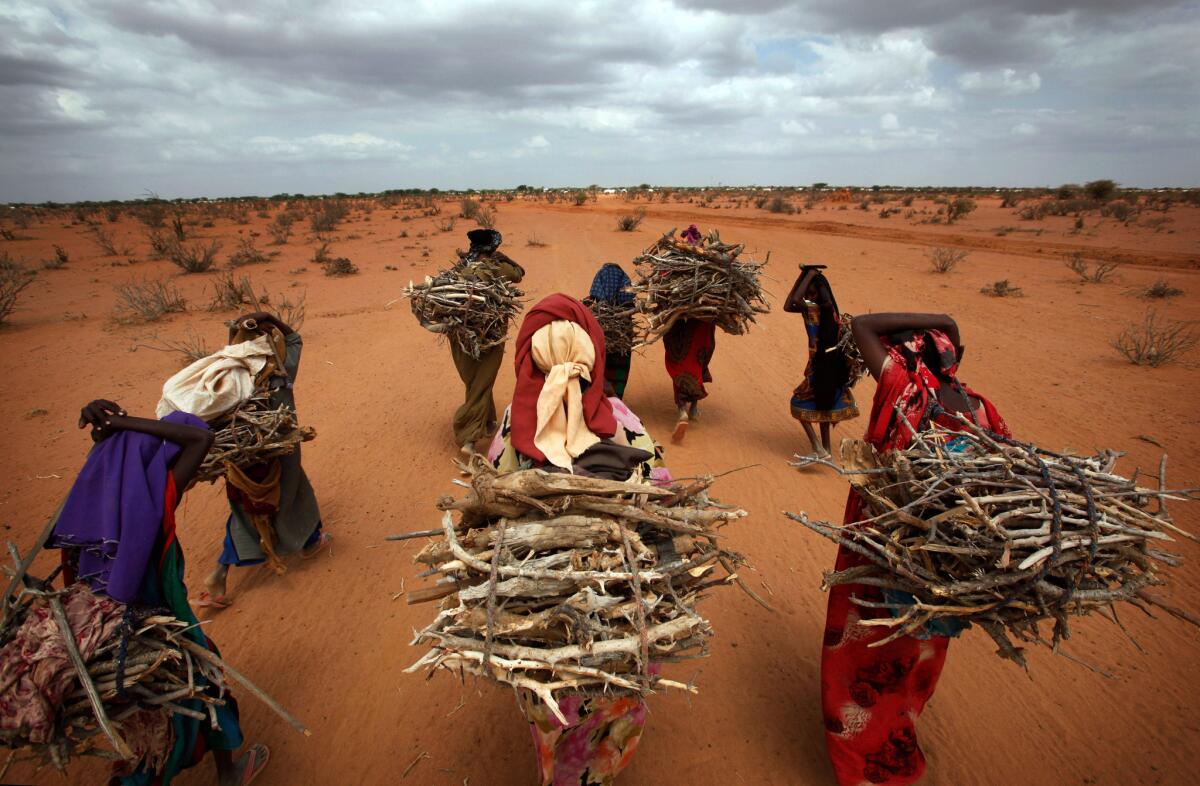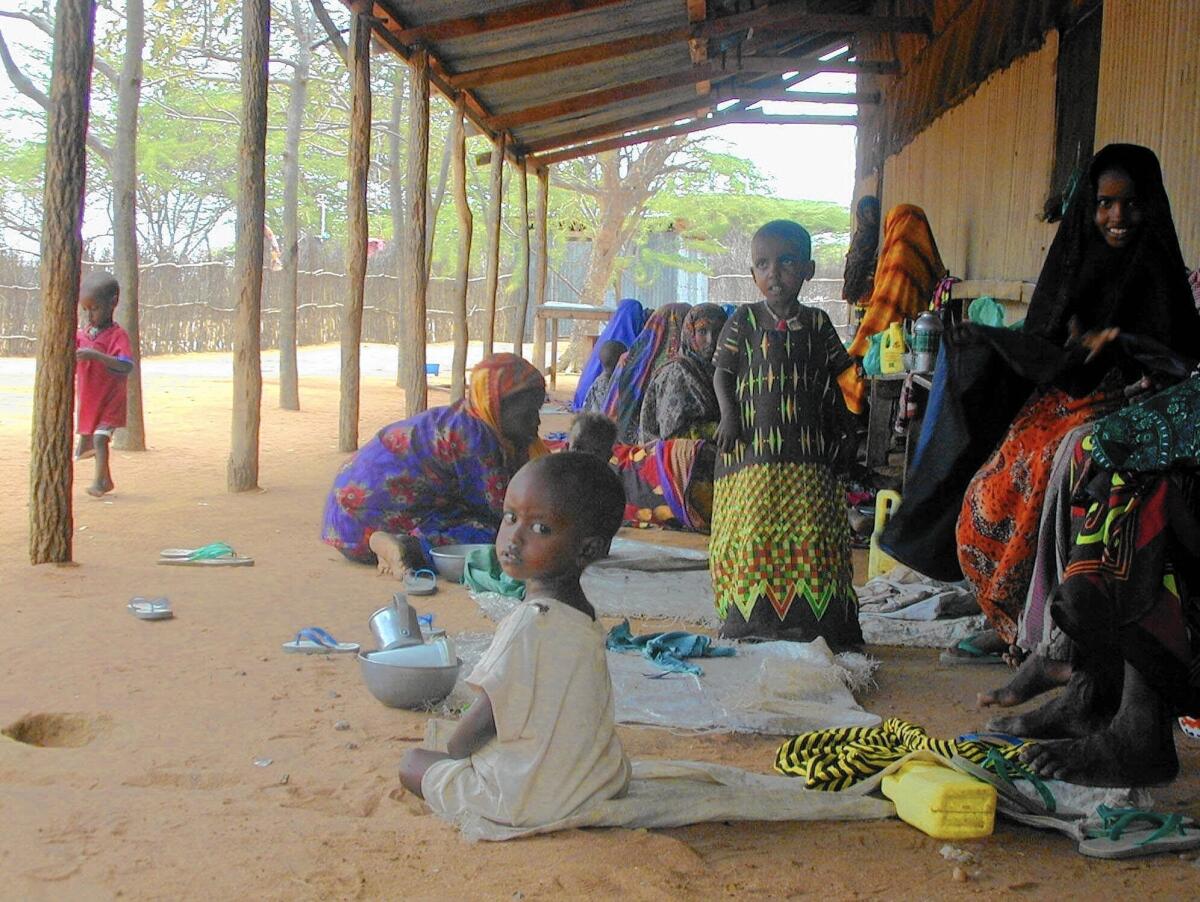Review: Dadaab refugee camp, detailed in ‘City of Thorns,’ is a world ripped from the world

Women venture to the camp outskirts to forage for firewood, and return bowed under the big bundles lashed to their backs. The Dadaab complex, built in the early 1990s, was originally designed to hold less than a fourth of its current population.
- Share via
The residents of the sprawling Dadaab camp in northern Kenya are living paradoxes: nationals of no nation, refugees who in many cases are also natives — born and raised in a state of anguished waiting.
This wasn’t supposed to happen. When Dadaab was established a quarter of a century ago, it was envisioned as a short-term shelter, mostly for Somalis fleeing war and famine. It was not meant to endure for two decades and become home to possibly as many as 600,000 people — though the official count is much smaller.
But a lesson of Ben Rawlence’s magisterial “City of Thorns: Nine Lives in the World’s Largest Refugee Camp” (Picador) is that the multitudes, driven by fear and want, are endowed with their own momentum. Their informal collective power overwhelms institutional designs.
As a result, little in Dadaab functions exactly as planned. A regional black-market economy flourishes in the absence of jobs, lynch mobs fill the law enforcement vacuum and the temporary camp appears to grow more permanent by the year.
Rawlence spent about five months there, beginning in 2011, building on six years of research he conducted for Human Rights Watch in the Horn of Africa. His chronicle focuses on the everyday lives of camp residents during a period when international-aid attention shifts to Syria, terrorism seizes Kenya, pressure mounts to close the camp and decisions made in European capitals reverberate down the lines of flimsy tents.

This is a tough assignment on many counts. Not only does “City of Thorns” represent hard, lonely work in a desolate place. It chooses the most difficult of subjects — a refugee camp already notorious for being the world’s largest and singled out for periodic saturation media coverage and celebrity visits by the likes of Angelina Jolie. Besides explaining the camp, Rawlence must pierce intellectual complacency toward what might seem wearily familiar fare.
That he succeeds is tribute to his commitment to reporting from the ground up. He keeps his lens narrow, basing his account almost entirely on observed detail and intimate discussions with residents.
We see Dadaab through an accumulation of vivid impressions — passed bottles of Fanta, couples bickering over money, bags of donated sorghum that no one knows how to cook, a pornographic picture of a white woman on a Muslim husband’s phone.
The people in the book — among others, a former child soldier, a youth leader, a drug addict — have flaws and virtues but are mostly striking for their ordinariness. It is their predicament that is extraordinary, and this makes their travails the more gripping.
“No one looked at the situation of the war and considered their options rationally,” Rawlence observes cannily, describing a youth’s heart-stopping escape from Somalia. “You took decisions like a rock climber on a treacherous face making one move at a time to stay alive.”
One surprise of this book is its suspense. It chronicles the lives of people trapped in soul-eroding tedium, yet it moves like a thriller. As conditions in the camp grow more desperate, one dread development follows another at a quickening pace: Aid workers are kidnapped. Then NGOs pull out. Latrines overflow, cholera erupts, violence stalks camp residents. The feeling, as the book progresses, is that of walls closing in.
The subjects cope as best they can, sometimes buckling. A man is so seized by envy when his sister wins resettlement in Canada that he is incapacitated for days, as if by flu. Residents compose false Facebook pages of imaginary lives in Cleveland, complete with photos of cars they don’t own. They huddle to discuss whether to attempt the “tahrib” — Somalis’ word for illegal migration to Europe.
No one is exempt from personal problems just because they reside at the heart of a massive humanitarian crisis. A young woman fleeing war is disappointed that a Caesarean has robbed her of the experience of natural childbirth; a couple’s marriage is strained by camp life — but also by the husband’s obsession with soccer.
A strange new refugee culture merges traditions of the Sufi pastoralists with Western values imbibed from aid workers. Camp residents are fluent in concepts such as democracy and “gender balance.” Yet they scan the sky for omens.
Rawlence describes a generation “marinated in the UN vocabulary their whole life.” But their mastery of English and NGO norms gets them exactly nowhere. They remain stuck, waiting for their lives to start.
One virtue of this book is to show us how thoroughly these lives are grafted onto that of a larger world, despite the camp’s nominal exile from it.
“City of Thorns” is as much about the rest of us as it is about the refugees it describes. It evolves into a meditation on the war on terror, the European refugee crisis, and corruption in the developing world without ever releasing its tight focus on Dadaab.
We are left to conclude that the residents of Dadaab — restless, deracinated, mostly young — have not been left behind by the times. They are its products, exiled in ways only modernity makes possible.
“This is part of the world,” a young man assures a despondent friend at one point. Rawlence doesn’t pause to say the obvious — that if you have to lay claim to the world, you’ve already left it.
But like so many of the truths in this book, this one transcends its context.
::
City of Thorns
Nine Lives in the World’s Largest Refugee Camp
Ben Rawlence
Picador: 400 pp., $26
More to Read
Sign up for our Book Club newsletter
Get the latest news, events and more from the Los Angeles Times Book Club, and help us get L.A. reading and talking.
You may occasionally receive promotional content from the Los Angeles Times.










